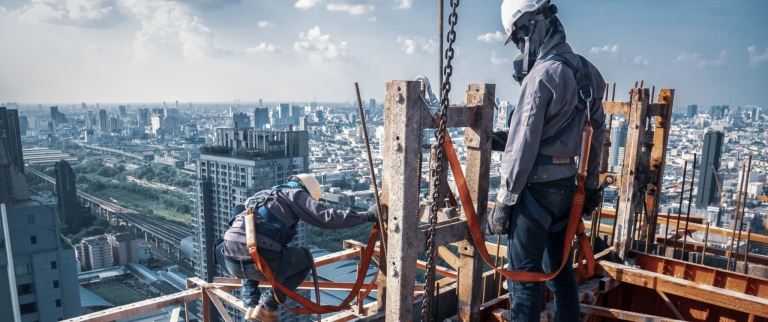July 17,2024
7 Shocking Safety Violations That Could Be Happening on Your Construction

7 Shocking Safety Violations That Could Be Happening on Your Construction Site Right Now – And Here’s How to Fix Them Fast!
Construction sites are dynamic and often hazardous environments. Ensuring safety is paramount to prevent accidents and injuries. However, common safety violations can compromise the well-being of workers and the success of projects. In this blog, we will identify some of the most frequent safety violations found on construction sites and provide practical solutions for mitigating these risks.
Common Safety Violations and Their Solutions
1. Inadequate Fall Protection
Violation: Falls are among the leading causes of injuries and fatalities on construction sites. Inadequate fall protection measures, such as missing guardrails, insufficient safety harnesses, and lack of proper scaffolding, are common violations.
Solution:
● Install Guardrails: Ensure guardrails are in place around all open edges, floor openings, and elevated work areas.
● Use Safety Harnesses: Provide workers with properly fitting safety harnesses and ensure they are trained in their use.
● Scaffold Safety: Inspect scaffolding regularly and ensure it is erected and used according to safety standards.
2. Poor Housekeeping
Violation: Cluttered work areas, debris, and improperly stored materials can create tripping hazards and obstruct emergency exits.
Solution:
● Regular Cleanups: Implement a routine cleanup schedule to keep the site organized and free of unnecessary materials.
● Proper Storage: Designate specific areas for storing tools and materials. Ensure these areas are easily accessible and not blocking walkways or exits.
● Clear Pathways: Keep pathways clear of debris and obstructions at all times.
3. Inadequate Personal Protective Equipment (PPE)
Violation: Failure to provide or enforce the use of appropriate PPE, such as helmets, gloves, goggles, and high-visibility clothing, is a common safety violation.
Solution:
● PPE Policy: Develop and enforce a comprehensive PPE policy that outlines the required protective gear for various tasks.
● Training: Conduct regular training sessions on the importance of PPE and proper usage.
● Availability: Ensure PPE is readily available to all workers and replace damaged or worn-out equipment promptly.
4. Electrical Hazards
Violation: Exposed wires, improper grounding, and lack of lockout/tagout procedures can lead to electrical shocks and fires.
Solution:
● Regular Inspections: Conduct regular inspections of electrical systems to identify and rectify hazards.
● Proper Grounding: Ensure all electrical equipment is properly grounded and maintained.
● Lockout/Tagout Procedures: Implement lockout/tagout procedures to ensure that electrical equipment is safely de-energized during maintenance.
5. Unsafe Use of Ladders and Scaffolding
Violation: Using ladders and scaffolding improperly, such as overloading, using damaged equipment, or not securing them properly, can lead to falls and injuries.
Solution:
● Inspection and Maintenance: Regularly inspect ladders and scaffolding for damage and ensure they are maintained in good condition.
● Proper Use Training: Train workers on the correct use of ladders and scaffolding, including load limits and securing methods.
● Secure Placement: Ensure ladders and scaffolding are placed on stable, level surfaces and are securely fastened.
6. Failure to Communicate Hazards
Violation: Not effectively communicating potential hazards and safety procedures to workers can result in accidents and injuries.
Solution:
● Safety Meetings: Hold regular safety meetings to discuss potential hazards and safety protocols.
● Clear Signage: Use clear and visible signage to warn workers of potential hazards and provide instructions.
● Open Communication: Encourage workers to report hazards and suggest improvements to safety practices.
7. Inadequate Training
Violation: Lack of proper training for workers on safe practices and equipment use can lead to unsafe behaviors and accidents.
Solution:
● Comprehensive Training Programs: Develop comprehensive training programs that cover all aspects of construction safety, including equipment use, hazard recognition, and emergency procedures.
● Regular Refresher Courses: Offer regular refresher courses to ensure that workers remain knowledgeable about safety practices.
● Onboarding Training: Provide thorough safety training for new employees before they begin work on the site.
Conclusion
Addressing common safety violations on construction sites is crucial for protecting workers and ensuring the smooth progression of projects. By identifying these violations and implementing effective solutions, companies can create safer work environments and minimize the risk of accidents. At Mtandt Group, we are committed to promoting safety and excellence in all our projects. For more information on our safety protocols and training programs, visit our website at www.mtandt.com.
Ensuring safety is not just a legal requirement but a moral obligation. By prioritizing safety and addressing violations proactively, we can protect our most valuable assets – our workers.